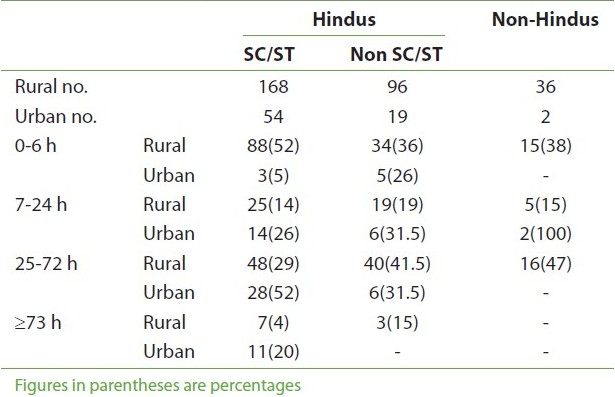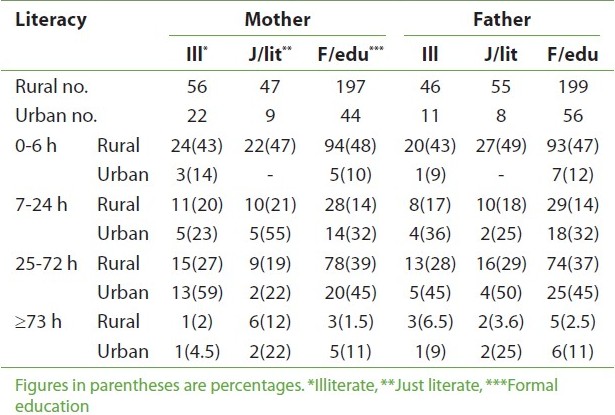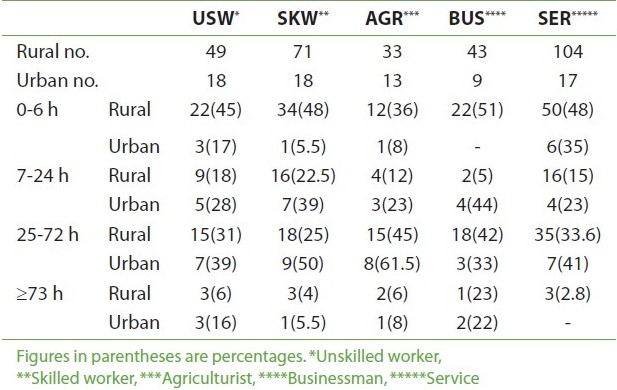| Abstract |
Research Question: What determines the trend in initiation of breastfeeding among lactating women? Objective: To assess the role of various factors in determining the initiation of breastfeeding among lactating women in block R. S. Pura of district Jammu. Material and Methods: A stratified two-stage design with villages as the primary sampling unit and lactating mothers as secondary sampling unit. Villages were divided into different clusters on the basis of population and sampling units were selected by a simple random technique. Results and Conclusion: Breastfeeding is almost universal in R. S. Pura. Education is a key determinant of early initiation of breastfeeding although there is slight variation between rural and urban areas.
Keywords: Breastfeeding, Determinants, Sampling
| How to cite this article: Raina SK, Mengi V, Singh G. Determinants in initiation of breastfeeding among lactating women in block R. S. Pura of district Jammu (India). Ann Trop Med Public Health 2011;4:71-3 |
| How to cite this URL: Raina SK, Mengi V, Singh G. Determinants in initiation of breastfeeding among lactating women in block R. S. Pura of district Jammu (India). Ann Trop Med Public Health [serial online] 2011 [cited 2017 Nov 14];4:71-3. Available from: https://www.atmph.org/text.asp?2011/4/2/71/85755 |
| Introduction |
Breastfeeding is the first fundamental right of a child. The initiation of breastfeeding and the timely introduction of adequate, safe and appropriate complementary foods in conjunction with continued breastfeeding are of prime importance for the growth, development, health and nutrition of infants and children everywhere. [1] The prevalence of breastfeeding in India is still high (99% in rural areas and 96% in urban areas). [2] However, there are many cultural practices associated with infant feeding of which certain undesirable like delayed initiation, need to be discouraged. Promotion of early initiation of breastfeeding has the potential to make a major contribution to the achievement of the child survival millennium development goal; 16% of neonatal deaths could be saved if all infants were breastfed from Day 1 and 22% if breastfeeding was started within the first hour. [3]
| Materials and Methods |
The study was conducted in block R. S. Pura of district Jammu. Jammu happens to be the winter capital of the J and K state of India with an estimated population of 4.5 million and diverse topography. The block is located in the southwest of Jammu city adjacent to the Indo-Pak border with a total area of 273 sq km and average density of 658/sq km. There are 176 villages and one town (11 wards) in the block with an estimated population of 1,79,636. [4] The majority of population comprises Hindus. The dimension of breastfeeding considered in this study was the time of initiation of breastfeeding and factors influencing it. The study population comprised 375 mothers of children less than one year (12 completed months) of age. The methodology comprised a stratified two-stage design which is in accordance with the IRMS (ICMR) Delhi methodology. The methodology used in rural and urban areas is as follows:
Rural area
In the design of the study, the stratification was according to the population size of the village. The village was the primary sampling unit and mothers the secondary sampling unit. One hundred and seventy-six villages of block R. S. Pura were stratified according to their population into four different strata as given:
Five villages were selected from each strata by simple random technique. Thus the total number of villages taken was 20.
Selection of mothers
From each village 15 mothers having children less than one year (12 completed months) of age at the time of study were picked up independent of each other. Thus the overall sample consisted of 300 mothers in the rural area.
The village selected was mapped and a house-to-house survey was conducted. Information on breastfeeding practices was collected.
Urban area
R. S. Pura town of block R. S. Pura was taken as the urban area for this study. Out of the 13 wards, five wards were selected randomly. The selected wards were identified with the help of an identification number. Fifteen mothers with children of less than one year (12 completed months) of age were picked from each ward, independent of each other. Thus the total number of mothers picked up from the urban area was 75.
The number of mothers was fixed at 75 keeping in view the rural-urban ratio of 80-20 in J and K state. The selection procedure adopted for mothers from the wards was similar to the one adopted for the villages in the rural area. The desired information on each selected mother was collected with the help of the same questionnaire as utilized for the rural areas and in the same manner.
| Discussion |
In the urban area, a higher percentage of nuclear families initiate breastfeeding late. Fifty-eight percent initiated as late as 25-72 h compared to rural areas wherein the majority (60%) initiated breastfeeding within 24 h [Table 1]. When a comparison was made for initiation of breastfeeding with regard to various social groups the differences were significant [Table 2]. It was seen that higher percentage of formally educated mothers and fathers recorded initiating breastfeeding in 0-6 h in the rural area (48% and 47% respectively). In urban areas, however, the formally educated showed higher preference to start breastfeeding around 25-72 h (45% each for educated mothers and fathers) [Table 3]. Occupation-wise there was not much difference as far as initiation of breastfeeding in the rural area was concerned. All occupations breastfed early at 0-6 h, with slight difference in percentages in the rural area. In urban areas all occupations preferred to start breastfeeding later than rural areas and started at 25-72 h [Table 4]. Infant feeding practices have significant effects on both mothers and children. Breastfeeding is almost universal in R. S. Pura but the differentials in breastfeeding are a cause for concern. The initiation of breastfeeding is delayed with more mothers starting breastfeeding late (25-72h). Breastfeeding was found to be practiced by almost all women in a study conducted by Gandotra, Sethi and Rishma [5] in a rural area of Jammu. The area of concern in this study was the involvement of lactating women in poor feeding practices. Differentials in the early initiation of breastfeeding and in discarding the first milk from the breast were not found to be important among various social-economic groups.
| Table 1: Time of initiation of breastfeeding among lactating mothers according to type of family
Click here to view |
 |
Table 2: Time of initiation of breastfeeding by lactating mothers according to caste/religion
Click here to view |
 |
Table 3: Time of initiation of breastfeeding among lactating mothers according to Literacy
Click here to view |
 |
Table 4: Time of initiation of breastfeeding according to occupation of father
Click here to view |
Maternal education was found to have no influence on the acceptance of breastfeeding according to a study by Mukhopadhya and Achar [6] in South India. The study showed, interalia, that a poor knowledge regarding infant feeding practices was prevalent among mothers despite their educational status.
| References |
| 1. | Kulkarni RN, Anjenaya S, Gujar S. Breast feeding practices in an urban community of Kalamboli, Navi Mumbai. Indian J Community Medicine 2004;29(4):179-80. |
| 2. | Ghai OP, Gupta P. Essential Preventive Medicine. New Delhi: Vikas Publishing House Pvt. Ltd; 1999. p. 537. |
| 3. | Edmond KM, Zandoh C, Quigley MA, Amenga-Etego S, Owusu-Agyei S, Kirkwood BR. Delayed breastfeeding initiation increases risk of neonatal mortality. Pediatrics 2006;117:e380-6. |
| 4. | Ahmed Feroze (IAS). Jammu and Kashmir provisional population. Director of census operations, series-2, paper-2, Delhi: Census of India; 2001. |
| 5. | Gandotra VK, Sethi N, Rishma G. A study of brest feeding practices and problems related to breast feeding in rural women. Health and Population. 1990;13:12-20. |
| 6. | Mukhopadhya J, Achar DP. Infant feeding practices among educated women in an air force community. Health and Population. 1990;15:89-93. |
Source of Support: None, Conflict of Interest: None
| Check |
DOI: 10.4103/1755-6783.85755
| Tables |
[Table 1], [Table 2], [Table 3], [Table 4]
| This article has been cited by | ||
| 1 | Determinants of initiation of breast feeding among lactating women in Sub-Himalayan region | |
| SunilKumar Raina,VishavChander Sharma,Ashok Bhardwaj,Ankush Kaushal | ||
| Journal of Medical Society. 2014; 28(2): 77 | ||
| [Pubmed] | [DOI] | ||



